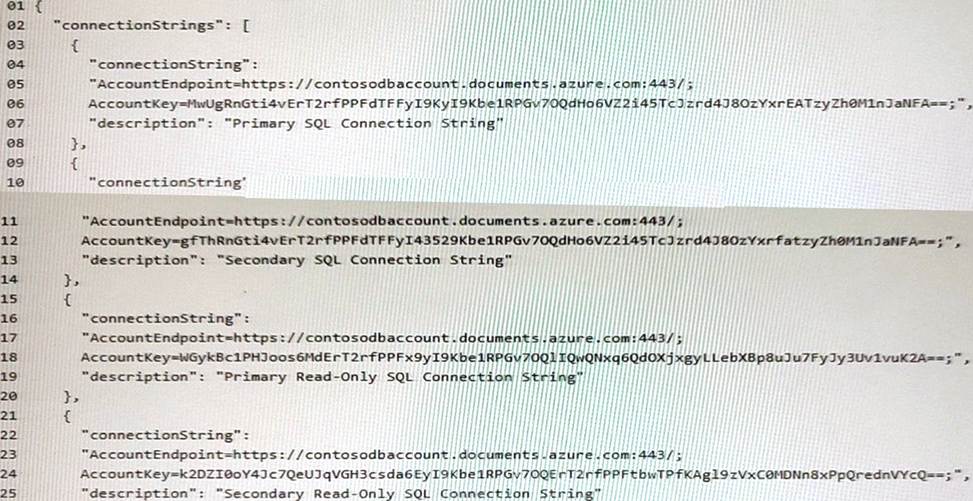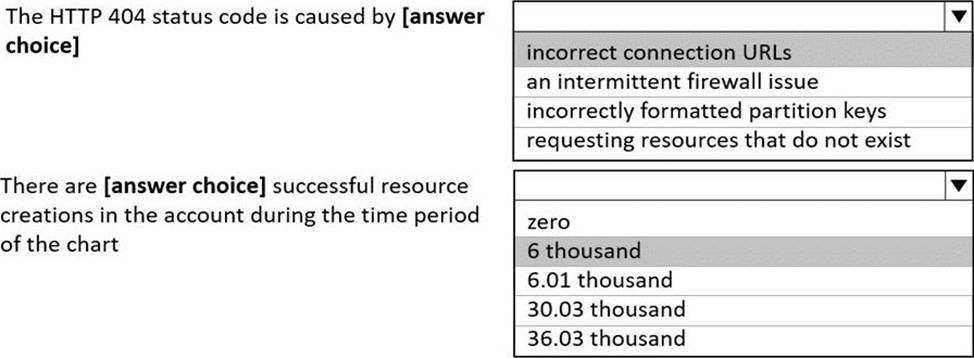Microsoft DP-420 Übungsprüfungen
Zuletzt aktualisiert am 19.10.2025- Prüfungscode: DP-420
- Prüfungsname: Designing and Implementing Cloud-Native Applications Using Microsoft Azure Cosmos DB
- Zertifizierungsanbieter: Microsoft
- Zuletzt aktualisiert am: 19.10.2025
HOTSPOT
You are developing an application that will connect to an Azure Cosmos DB for NoSQL account. The account has a single readme region and one agonal read region. The regions are configured for automatic failover.
The account has the following connect strings. (Line numbers are included for reference only.)

For each of the following statements, select Yes if the statement is true. otherwise, select No. NOTE: Each correct selection is worth one point.

You need to implement a solution to meet the product catalog requirements.
What should you do to implement the conflict resolution policy.
- A . Remove frequently changed field from the index policy of the con-product container.
- B . Disable indexing on all fields in the index policy of the con-product container.
- C . Set the default consistency level for account1 to eventual.
- D . Create a new container and migrate the product catalog data to the new container.
You have an Azure Cosmos DB Core (SQL) API account.
You run the following query against a container in the account.
SELECT
IS_NUMBER("1234") AS A,
IS_NUMBER(1234) AS B,
IS_NUMBER({prop: 1234}) AS C
What is the output of the query?
- A . [{"A": false, "B": true, "C": false}]
- B . [{"A": true, "B": false, "C": true}]
- C . [{"A": true, "B": true, "C": false}]
- D . [{"A": true, "B": true, "C": true}]
Note: This question is part of a series of questions that present the same scenario. Each question in the series contains a unique solution that might meet the stated goals. Some question sets might have more than one correct solution, while others might not have a correct solution.
After you answer a question in this section, you will NOT be able to return to it. As a result, these questions will not appear in the review screen.
You have a container named container! in an Azure Cosmos DB for NoSQL account.
You need to make the contents of container1 available as reference data for an Azure Stream Analytics job.
Solution: You create an Azure function that uses the Azure Cosmos 08 for NoSQL change feed as a
trigger and an Azure event hub as the output.
Does this meet the goal?
- A . Yes
- B . No
HOTSPOT
You configure Azure Cognitive Search to index a container in an Azure Cosmos DB Core (SQL) API account as shown in the following exhibit.

Use the drop-down menus to select the answer choice that completes each statement based on the information presented in the graphic. NOTE: Each correct selection is worth one point.

Note: This question is part of a series of questions that present the same scenario. Each question in the series contains a unique solution that might meet the stated goals. Some question sett might have more than one correct solution, while others might not have a correct solution.
After you answer a question in this section, you will NOT be able to return to it. As a result, these questions will not appear in the review screen.
You have a container named conlainer1 in an Azure Cosmos DB for NoSQL account.
You need to make the contents of container1 available as reference data for an Azure Stream Analytics job.
Solution: You create an Azure function to copy data to another Azure Cosmos DB for NoSQL container.
Does this meet the goal?
- A . Yes
- B . No
HOTSPOT
You have an Azure Cosmos DB Core (SQL) API account used by an application named App1.
You open the Insights pane for the account and see the following chart.

Use the drop-down menus to select the answer choice that answers each question based on the information presented in the graphic. NOTE: Each correct selection is worth one point.

You are building an application that will store data in an Azure Cosmos DB for NoSQL account. The account uses the session default consistency level. The account is used by five other applications. The account has a single read-write region and 10 additional read regions. Approximately 20 percent of the items stored in the account are updated hourly.
Several users will access the new application from multiple devices.
You need to ensure that the users see the same item values consistently when they browse from the different devices. The solution must not affect the other applications.
Which two actions should you perform? Each correct answer presents part of the solution. NOTE: Each correct selection is worth one point.
- A . Use implicit session management when performing read requests.
- B . Provide a stored session token when performing read requests.
- C . Associate a session token to the user account.
- D . Set the default consistency level to eventual.
- E . Associate a session token to the device.
You have an Azure Cosmos DB for NoSQL account that contains a database named DB1 and a container named Container1. You need to manage the account by using the Azure Cosmos DB SDK.
What should you do?
- A . List the physical partitions of Container1.
- B . Read a stored procedure in Container1.
- C . Create a user defined function (UDF) in Container1.
- D . Create a container in DB1.
You have a container named container! in an Azure Cosmos DB for NoSQL account.
You need to provide a user named User1 with the ability to insert items into container1 by using role-based access The solution must use the principle of least privilege.
Which roles should you assign to User1?
- A . Cosmos DB Built-in Data Contributor only
- B . Cosmos DB Operator only
- C . DocumentDB Account Contribute only
- D . DocumentDB Account Contributor and Cosmos DB Built-in Data Contributor



